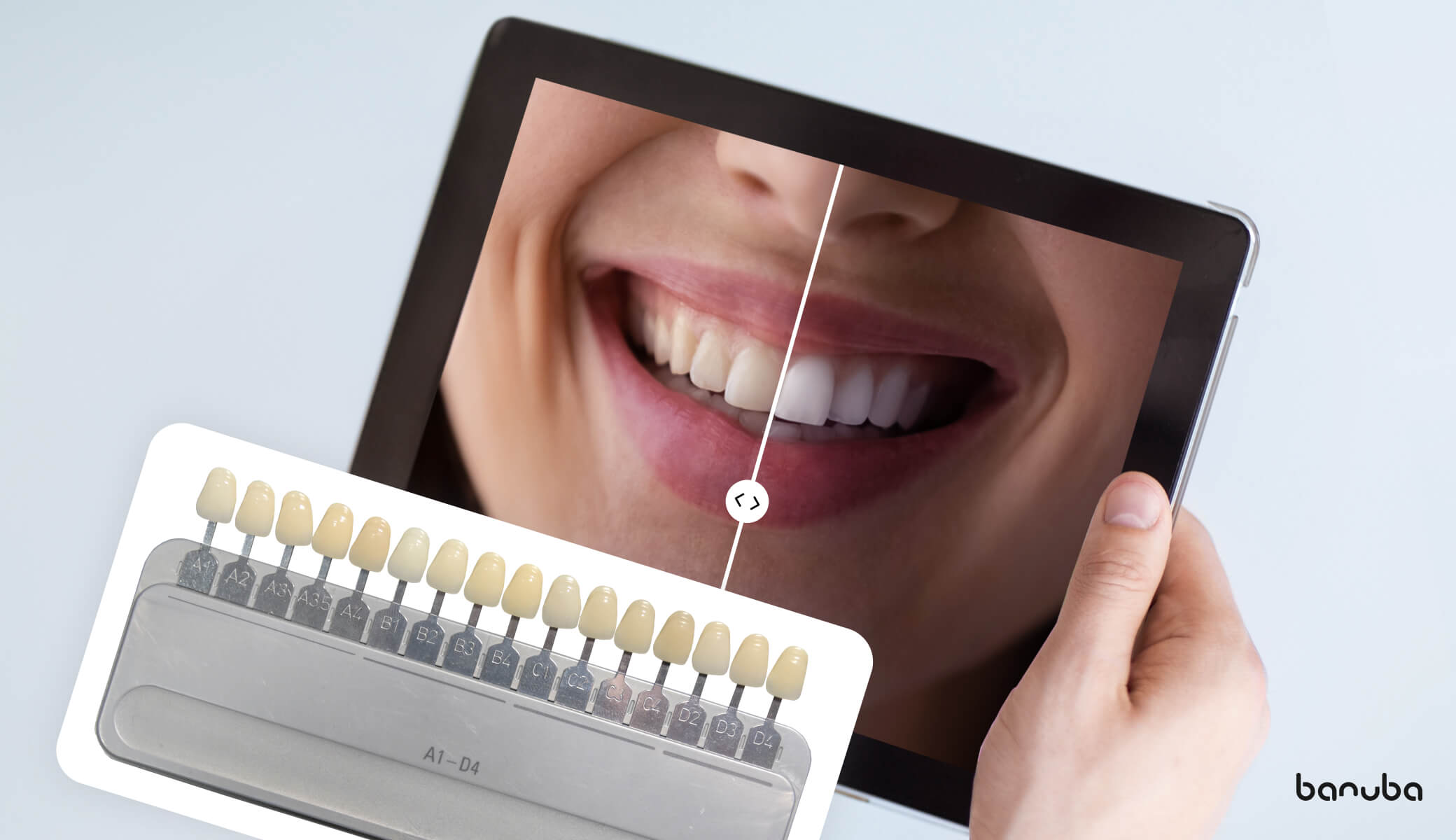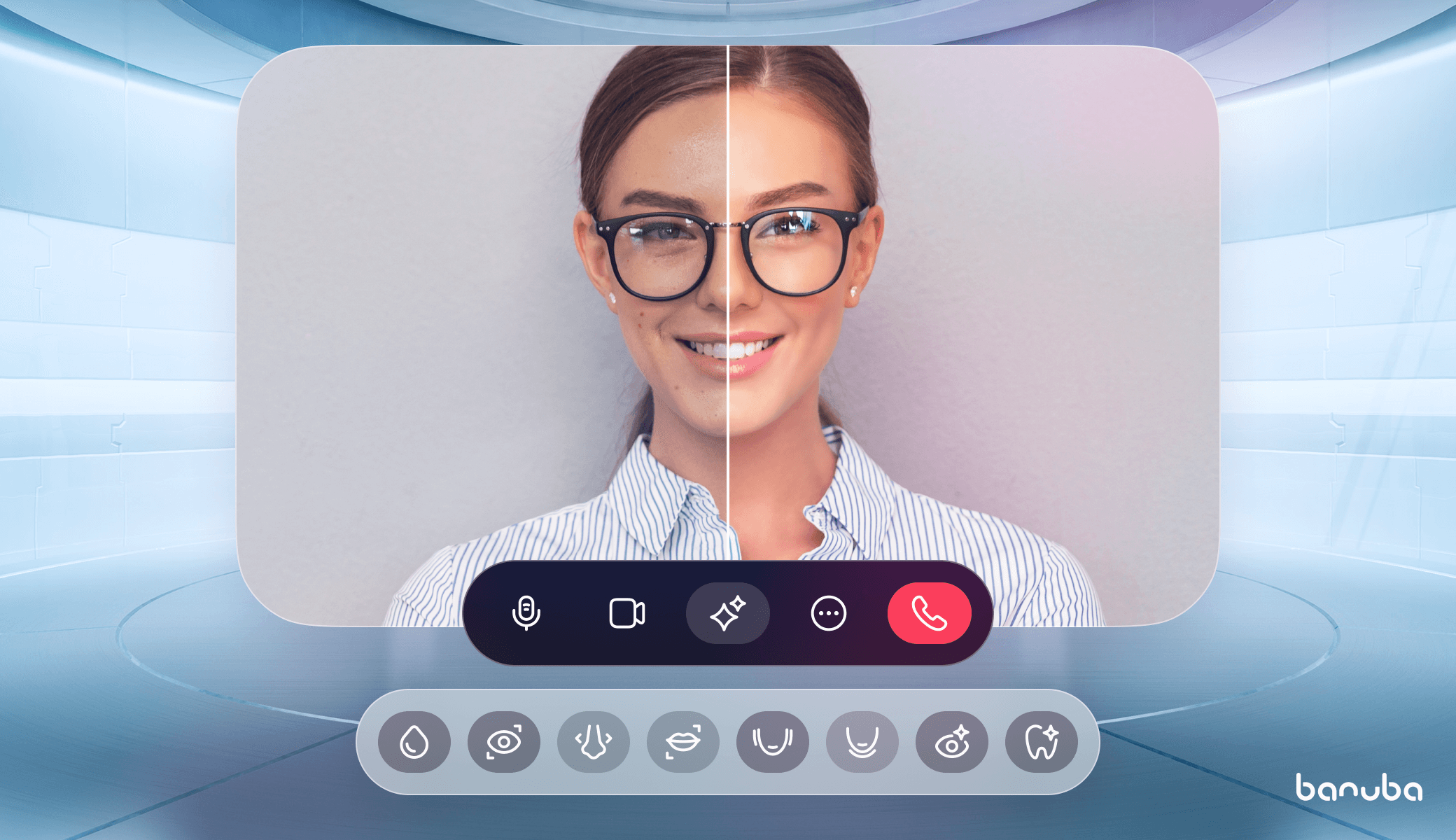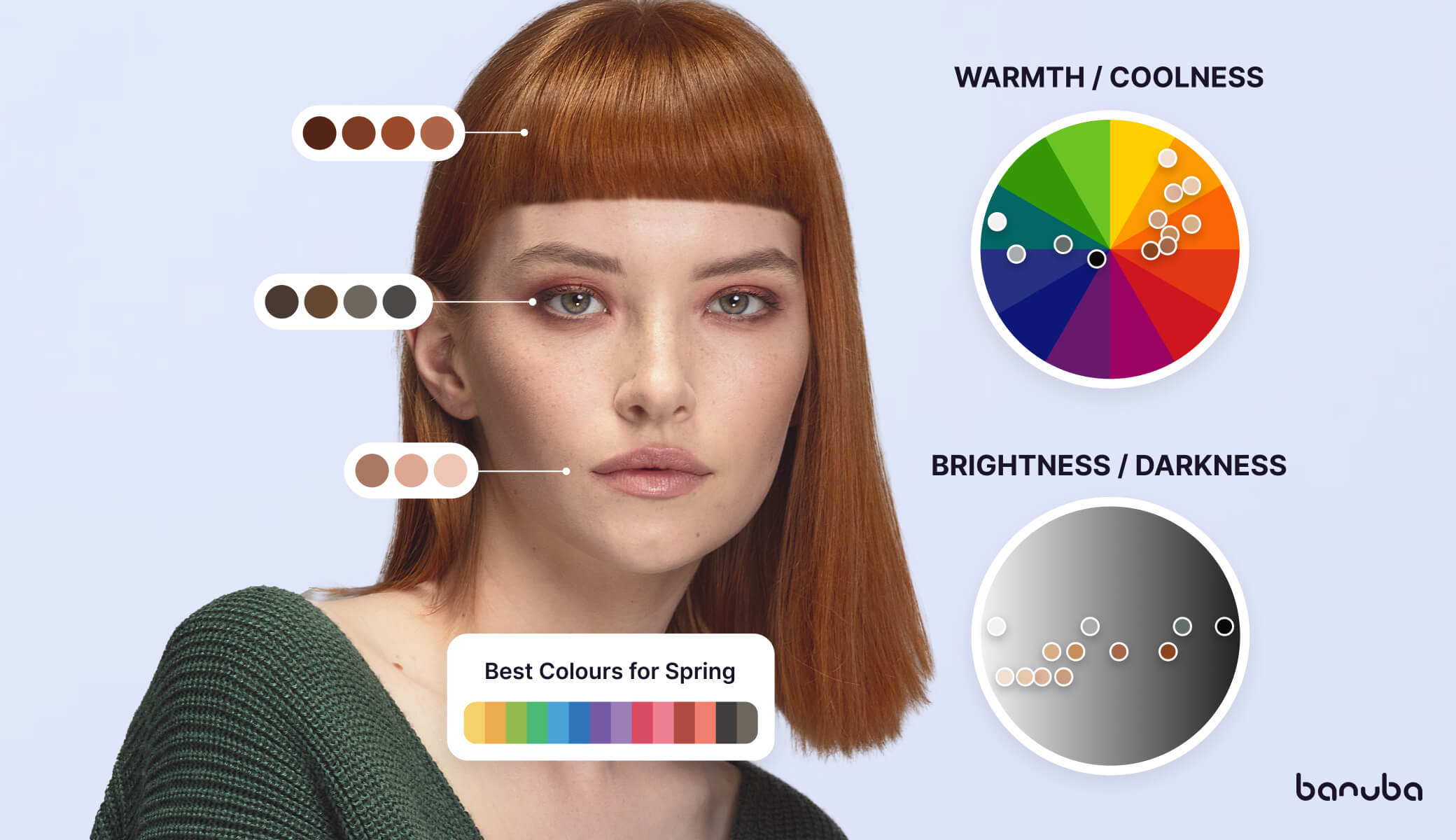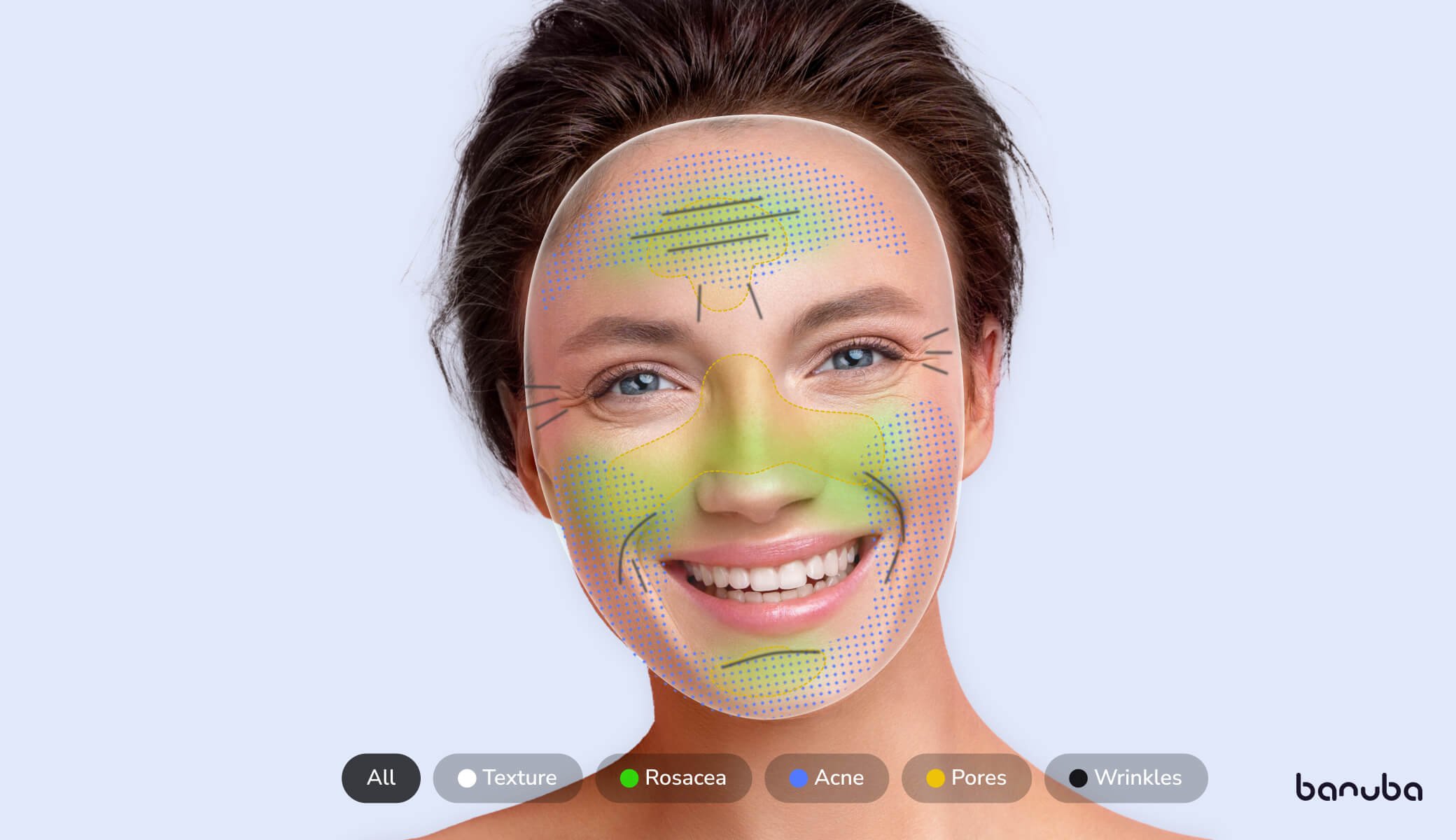[navigation]
TL;DR
- 1 in 4 Americans are ashamed of their smile and avoid socializing because of it; Millennials are the largest potential audience; Teeth whitening tops the in-office procedure list;
- Millennials and Gen Z are 72% more likely to use AR frequently, boosting the popularity of virtual smile makeover solutions in dentistry;
- Along with dental clinics, digital smile simulation is also used in video editing, video conferencing, and social media;
- Banuba Dental Tech AR, SmileFy AI Smile Simulation, and TRIOS Smile Design AR are three AR tech leaders in the dental industry — check out the comparison table below.
Brief Dental Industry Overview
We have already discussed the four biggest trends in the industry in 2024, including dental technology AR solutions. Dental tech enhancement and the appearance of sustainable and painless solutions made oral care more appealing and accessible.

I want to concentrate more on the behavior and needs of your potential patients and how this affects the overall picture of the aesthetic dentistry industry. According to the Dental American Association report, every fourth American avoids smiling due to poor teeth conditions, and 22% of adults reduce their social activities. That’s the potential audience dental clinics have to target. But how to approach them?
The teeth whitening procedure is the most popular in the US, comprising 32% of all in-office treatments. Millennials (aged 24-35) are the largest potential audience, reaching 79%. Influenced by celebrities and social media influencers, they strive for perfect smile makeovers. Considering their love for technological advancement, implementing digital smile simulation solutions sounds like a win-win scenario. According to Snap Consumer AR Global Report, this generation group and Gen Z are 72% more likely to be frequent AR users.
Virtual Smile Makeover Use Cases
If everything seems clear to you about the teeth simulator application in the dental field, I've prepared some unexpected use cases for you. I also couldn't ignore other areas where digital smile simulation is booming.

Dental Clinics
If digital smile simulation had existed when I was a teenager, I would have had braces back then without hesitation instead of starting treatment at the age of 27. Dental clinics increasingly adopt virtual smile makeover tools to enhance patient care and marketing strategies.
Technologies like Banuba's Dental Tech AR enable clinics to offer real-time smile simulations, helping patients visualize potential outcomes before committing to treatments. This not only builds trust but also improves treatment acceptance rates.
For marketing, clinics can leverage these tools to create engaging social media filters that promote their services, such as teeth whitening.
Imagine inviting your patients for annual check-ups via email with free digital smile simulation and a teeth-whitening virtual try-on as a gentle reminder to get rid of those stubborn coffee stains. A simple email campaign with integrated smile simulations is hyper-personalized and engaging, with chances to increase your conversion rates by 94%.
You can add a virtual smile makeover page to your website and enjoy an extra touchpoint, leveraging an omnichannel marketing approach without additional human resources. Due to the popularity of dental tourism, a digital smile simulation can be a crucial factor for buying that airplane ticket and booking an appointment at your clinic.

Video Conferencing
Have you drunk too many cups of coffee before a sales pitch? Does the red lipstick make your teeth look yellowish? Smile simulators integrated into video conferencing platforms offer an innovative way to enhance virtual interactions, particularly in professional settings where appearance can influence communication.
By using AR technology to adjust and enhance smiles in real time, these tools help users present a polished appearance during meetings, reducing the need for physical enhancements or post-production teeth whitening in video editing. This can be particularly beneficial in customer-facing roles, remote job interviews, or any scenario where first impressions are crucial. Tools like Banuba’s Face AR SDK, which includes real-time teeth whitening and virtual smile makeover features, can be embedded directly into video conferencing software to give users an instant confidence boost during important calls.

Social Media
Smile simulators on social media are becoming a popular tool for content creators and brands. AR-powered filters that enhance smiles allow users to create engaging, shareable content that can increase interaction rates. Brands, particularly those in the beauty, fashion, or health industries, can use these tools to create sponsored content that resonates with their audience, encouraging user-generated content and viral trends.
For instance, a beauty brand might release an AR filter that whitens teeth in a video or enhances a user’s smile, promoting their dental care products subtly yet effectively. This approach boosts brand visibility and encourages users to try out virtual products, increasing the likelihood of conversion to actual sales.
Video Editing
The video definitely sits on the Iron Throne, unlike other types of content in 2024. Every day, 100 million users watch a video online. Which brings us to lots of video editing. Smile simulators offer powerful post-production tools that can be used to enhance smiles and whiten teeth across video content, making them invaluable for content creators, marketers, and media professionals.
These tools can be used to improve the visual appeal of videos without requiring extensive manual editing. For example, a marketing team creating a promotional video might use smile simulator software to ensure that all participants have perfect, bright smiles, thereby enhancing the overall impact of the video. This technology is especially useful in industries where appearance and aesthetics are critical, such as advertising, film production, and online video content.
Digital Smile Simulation Tech Solutions
The choice of a virtual smile makeover software depends on your clinic’s needs and objectives. I’ve analyzed three top teeth simulator solutions on the market to save you time.

Face AR SDK from Banuba
Banuba's Face AR SDK is a cutting-edge teeth whitening tool that enhances patient consultations through advanced AR technology. This industry-leading solution is renowned for its cross-platform compatibility—supporting mobile, web, and desktop applications. The SDK operates smoothly online and offline, making it highly versatile for various clinical environments.

In its latest update, Banuba has introduced features that directly address the needs of dental clinics. Using the industry standard tone scale, Banuba's teeth simulator delivers realistic, natural-looking whitening that accurately matches any enamel color. Doctors and patients can digitally try on a whiter smile, helping to boost their confidence in the proposed treatment.
One of the key advantages of Banuba's SDK is its proprietary technology, which is protected by relevant patents, ensuring a smooth, real-time performance without the need for special hardware. Delivered as an SDK, this solution is designed to be easily integrated into existing mobile and web applications, serving as a powerful addition to clinics' current patient interaction tools. While it excels in teeth whitening, it's important to note that this tool is specialized for enhancing the appearance of existing teeth and does not alter or reconstruct tooth shape. For clinics needing to showcase orthodontic treatment results, let's review other tools below.

SmileFy AI Smile Simulation
SmileFy AI Smile Simulation offers a powerful AI-driven virtual teeth makeover tool specifically designed for cosmetic dentistry. It enables dentists to create highly realistic smile simulations of potential treatment outcomes, allowing patients to visualize the results before any procedures are performed. This technology is particularly valuable in cosmetic dentistry, where patient expectations can be high and the margin for error is small. The digital smile simulation capabilities are supported by a comprehensive set of tools that allow for precise tooth shape, size, and alignment adjustments, giving patients a clear and accurate preview of their new smile. The platform’s ease of use and accessibility on various devices make it an excellent choice for practices prioritizing patient satisfaction and streamlined consultation processes.
TRIOS Smile Design AR from 3Shape
TRIOS Smile Design from 3Shape integrates seamlessly with its intraoral scanners, making it a perfect fit for clinics already using this technology. What sets the teeth simulator apart is its ability to leverage detailed digital scans to create highly precise and customizable treatment plans. This integration not only enhances the accuracy of the smile simulations but also ensures that the entire process—from scanning to final treatment—is streamlined and efficient.
The software allows dentists to quickly generate and modify digital models, facilitating a more collaborative consultation process where patients can see and discuss the proposed changes in real-time.
Conclusion
In the world of virtual offices and metaverse stores, choosing the right color of veneer or matching the desired whitening result by applying a ceramic onlay to a patient's mouth is no longer old-school but cringe. Don’t be me. Don’t wait another 13 years for a virtual smile makeover. Choose your AR dental tech partner not to lag behind. Or give it a free try.













